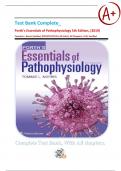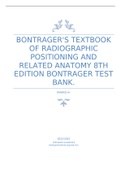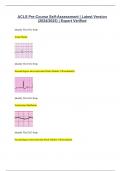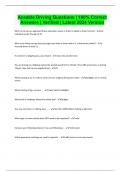Test Bank Complete_
Porth's Essentials of Pathophysiology 5th Edition, (2019)
Tommie L. Norris (Author) 9781975107192| All Units| All Chapters 1-52| Verified
5TH EDITION
,TABLE OF CONTENTS
UNIT 1 • CONCEPTS OF HEALTH AND DISEASE ---------------------------------------------------------- 5
Chapter 1: Concepts Of Health And Disease --------------------------------------------------------------------- 5
UNIT 2 • CELL FUNCTION AND GROWTH ---------------------------------------------------------------- 23
Chapter 2: Cell And Tissue Characteristics ----------------------------------------------------------------------- 23
Chapter 3: Cellular Adaptation, Injury, And Death ------------------------------------------------------------ 39
Chapter 4: Genetic Control Of Cell Function And Inheritance ---------------------------------------------- 55
Chapter 5: Genetic And Congenital Disorders ------------------------------------------------------------------ 72
Chapter 6: Neoplasia -------------------------------------------------------------------------------------------------- 88
UNIT 3 • DISORDERS OF INTEGRATIVE FUNCTION -------------------------------------------------- 105
Chapter 7: Stress And Adaptation-------------------------------------------------------------------------------- 105
Chapter 8: Disorders Of Fluid And Electrolyte And Acid Base Balance --------------------------------- 121
UNIT 4 • INFECTION, INFLAMMATION, AND IMMUNITY ------------------------------------------ 137
Chapter 9: Inflammation, Tissue Repair, And Wound Healing ------------------------------------------- 137
Chapter 10: Mechanisms Of Infectious Disease -------------------------------------------------------------- 153
Chapter 11: Innate And Adaptive Immunity ------------------------------------------------------------------ 169
Chapter 12 Disorders of the Immune Response, Including HIV/AIDS ---------------------------------- 185
UNIT 5 • DISORDERS OF NEURAL FUNCTION --------------------------------------------------------- 202
Chapter 13: Organization And Control Of Neural Function ----------------------------------------------- 202
Chapter 14: Somatosensory Function, Pain, Headache, and Temperature Regulation ----------- 219
Chapter 15: Disorders Of Motor Function --------------------------------------------------------------------- 236
Chapter 16: Disorders Of Brain Function ----------------------------------------------------------------------- 252
Chapter 17: Sleep and Sleep–Wake Disorders ---------------------------------------------------------------- 269
Chapter 18: Disorders Of Thought, Emotion, And Memory ----------------------------------------------- 285
UNIT 6 • DISORDERS OF SPECIAL SENSORY FUNCTION -------------------------------------------- 301
Chapter 19: Disorders Of Visual Function ---------------------------------------------------------------------- 301
Chapter 20: Disorders Of Hearing And Vestibular Function ---------------------------------------------- 317
UNIT 7 • DISORDERS OF THE HEMATOPOIETIC SYSTEM ------------------------------------------- 334
Chapter 21: Blood Cells And The Hematopoietic System -------------------------------------------------- 334
Chapter 22: Disorders Of Hemostasis --------------------------------------------------------------------------- 348
Chapter 23: Disorders Of Red Blood Cells ---------------------------------------------------------------------- 365
Chapter 24: Disorders Of White Blood Cells And Lymphoid Tissues ------------------------------------ 381
,UNIT 8 • DISORDERS OF CARDIOVASCULAR FUNCTION ------------------------------------------- 398
Chapter 25: Structure And Function Of The Cardiovascular System ------------------------------------ 398
Chapter 26: Disorders of Blood Flow and Blood Pressure Regulation --------------------------------- 415
Chapter 27: Disorders Of Cardiac Function, And Heart Failure And Circulatory Shock ------------ 431
Chapter 28: Disorders Of Cardiac Conduction And Rhythm ---------------------------------------------- 449
UNIT 9 • DISORDERS OF RESPIRATORY FUNCTION ------------------------------------------------- 467
Chapter 29: Structure And Function Of The Respiratory System ---------------------------------------- 467
Chapter 30: Respiratory Tract Infections, Neoplasms, and Childhood Disorders ------------------- 483
Chapter 31: Disorders Of Ventilation And Gas Exchange -------------------------------------------------- 499
UNIT 10 • DISORDERS OF RENAL FUNCTION --------------------------------------------------------- 514
Chapter 32 Structure And Function Of The Kidney ---------------------------------------------------------- 514
Chapter 33: Disorders Of Renal Function ---------------------------------------------------------------------- 529
Chapter 34: Acute Kidney Injury And Chronic Kidney Disease ------------------------------------------- 545
Chapter 35: Disorders Of The Bladder And Lower Urinary Tract ---------------------------------------- 564
UNIT 11 • DISORDERS OF GASTROINTESTINAL FUNCTION ---------------------------------------- 581
Chapter 36: Structure And Function Of The Gastrointestinal System ---------------------------------- 581
Chapter 37: Disorders Of Gastrointestinal Function -------------------------------------------------------- 598
Chapter 38: Disorders Of Hepatobiliary And Pancreas Function ---------------------------------------- 617
Chapter 39: Alterations In Nutritional Status ----------------------------------------------------------------- 636
UNIT 12 • DISORDERS OF ENDOCRINE FUNCTION -------------------------------------------------- 653
Chapter 40: Mechanisms Of Endocrine Control -------------------------------------------------------------- 653
Chapter 41: Disorders of Endocrine Control of Growth and Metabolism ----------------------------- 669
UNIT 13 • DISORDERS OF GENITOURINARY AND REPRODUCTIVE FUNCTION --------------- 686
Chapter 42: Structure and Function of the Male Genitourinary System ------------------------------ 686
Chapter 43: Disorders Of The Male Reproductive System ------------------------------------------------ 703
Chapter 44: Structure And Function Of The Female Reproductive System --------------------------- 720
Chapter 45: Disorders Of The Female Reproductive System --------------------------------------------- 737
Chapter 46: Sexually Transmitted Infections------------------------------------------------------------------ 754
UNIT 14 • DISORDERS OF MUSCULOSKELETAL FUNCTION ---------------------------------------- 771
Chapter 47: Structure And Function Of The Musculoskeletal System---------------------------------- 771
Chapter 48: Disorders Of Musculoskeletal Function: Trauma, Infection, And Neoplasms ------- 788
Chapter 49: Disorders of Musculoskeletal Function: Developmental and Metabolic Disorders,
Activity Intolerance, and Fatigue --------------------------------------------------------------------------------- 807
Chapter 50: Disorders Of Musculoskeletal Function: Rheumatic Disorders -------------------------- 824
,UNIT 15 • DISORDERS OF INTEGUMENTARY FUNCTION ------------------------------------------ 843
Chapter 51: Structure And Function Of The Skin------------------------------------------------------------- 843
Chapter 52: Disorders Of Skin Integrity And Function ------------------------------------------------------ 858
,UNIT 1 • CONCEPTS OF HEALTH AND DISEASE
Chapter 1: Concepts Of Health And Disease
Tommie Norris: Porths Essentials of Pathophysiology 5th Edition, (2019) Test Bank
MULTIPLE CHOICE
1. While Attending An International Nursing Conference, Many Discussions And
Break-Out Sessions Focused On The World Health Organization's (WHO) Views On
Health. Of The Following Comments Made By Nurses During A Discussion Session,
Which Statements Would Be Considered A Good Representation Of The WHO
Definition? Select All That Apply.
A. Interests In Keeping The Older Adult Population Engaged In Such Activities As
Book Reviews And Word Games During Social Time
B. Increase In The Number Of Chair Aerobics Classes Provided In The Skilled Care
Facilities
C. Interventions Geared Toward Keeping The Older Adult Population Diagnosed
With Diabetes Mellitus Under Tight Blood Glucose Control By Providing In-Home
Cooking Classes
D. Providing Transportation For Renal Dialysis Clients To And From Their
Haemodialysis Sessions
E. Providing Handwashing Teaching Sessions To A Group Of Young Children
CORRECT ANS: A, B, C, E
Rationale: WHO Definition Of Health Is Defined As "A State Of Complete Physical,
Mental, And Social Well-Being And Not Merely The Absence Of Disease And
Infirmity." Engaging In Book Reviews Facilitates Mental And Social Well-Being;
Chair Aerobics Helps Facilitate Physical Well-Being; And Assisting With Tight
Control Of Diabetes Helps With Facilitating Physical Well-Being (Even Though The
Person Has A Chronic Disease). Handwashing Is Vital In The Prevention Of Disease
And Spread Of Germs.
Question Format: Multiple Select
,Chapter 1: Concepts Of Health And Disease
Cognitive Level: Apply
Client Needs: Safe, Effective Care Environment: Management Of Care
Reference: P. 2
2. A Community Health Nurse Is Teaching A Group Of Recent Graduates About The
Large Variety Of Factors That Influence An Individual's Health Or Lack Thereof. The
Nurse Is Referring To The Healthy People 2020 Report From The U.S. Department
Of Health And Human Services As A Teaching Example. Of The Following Aspects
Discussed, Which Would Be Considered A Determinant Of Health That Is Outside
The Focus Of This Report?
A. The Client Has A Diverse Background By Being Of Asian And Native
American/First Nation Descent And Practices Various Alternative Therapies To
Minimize Effects Of Stress.
B. The Client Has A Family History Of Cardiovascular Disease Related To
Hypercholesterolemia And Remains Noncompliant With The Treatment Regime.
C. The Client Has A Good Career With Exceptional Preventive Health Care Benefits.
D. The Client Lives In An Affluent, Clean, Suburban Community With Access To
Many Health Care Facilities.
CORRECT ANS: B
Rationale: In Healthy People 2020, The Focus Is To Promote Good Health To All
(Such As Using Alternative Therapies To Minimize Effects Of Stress); Achieving
Health Equity And Promoting Health For All (Which Includes Having Good Health
Care Benefits); And Promoting Good Health (Which Includes Living In A Clean
Community With Good Access To Health Care). Being Noncompliant With
Treatments To Control High Cholesterol Levels With A Family History To CV
Disease Does Not Meet The "Attaining Lives Free Of Preventable Disease And
Premature Death" Goal/Objective.
Question Format: Multiple Choice
Chapter 1: Concepts Of Health And Disease
Cognitive Level: Apply
Client Needs: Health Promotion And Maintenance
,Reference: P. 2
3. A Member Of The Health Care Team Is Researching The Etiology And
Pathogenesis Of A Number Of Clients Who Are Under His Care In A Hospital
Context. Which Aspect Of Clients' Situations Best Characterizes Pathogenesis Rather
Than Etiology?
A. A Client Who Has Been Exposed To The Mycobacterium Tuberculosis Bacterium.
B. A Client Who Is Has Increasing Serum Ammonia Levels Due To Liver Cirrhosis.
C. A Client Who Was Admitted With The Effects Of Methyl Alcohol Poisoning.
D. A Client With Multiple Skeletal Injuries Secondary To A Motor Vehicle Accident.
CORRECT ANS: B
Rationale: Pathogenesis Refers To The Progressive And Evolutionary Course Of
Disease, Such As The Increasing Ammonia Levels That Accompany Liver Disease.
Bacteria, Poisons, And Traumatic Injuries Are Examples Of Etiologic Factors.
Question Format: Multiple Choice
Chapter 1: Concepts Of Health And Disease
Cognitive Level: Apply
Client Needs: Physiological Integrity: Physiological Adaptation
Reference: P. 3
4. A New Client Who Suffered A Myocardial Infarction Requires Angioplasty And
Stent Placement. He Has Arrived To His First Cardiac Rehabilitation Appointment. In
This First Session, A Review Of The Pathogenesis Of Coronary Artery Disease Is
Addressed. Which Statement By The Client Verifies To The Nurse That He Has
Understood The Nurse's Teachings About Coronary Artery Disease?
A. "All I Have To Do Is Stop Smoking And Then I Won't Have Any More Heart
Attacks."
B. "My Artery Was Clogged By Fat So I Will Need To Stop Eating Fatty Foods Like
French Fries Every Day."
C. "Sounds Like This Began Because Of Inflammation Inside My Artery That Made
It Easy To Form Fatty Streaks Which Led To My Clogged Artery."
, D. " If You Do Not Exercise Regularly To Get Your Heart Rate Up, Blood Pools In
The Veins Causing A Clot Which Stops Blood Flow To The Muscle And You Have
A Heart Attack."
CORRECT ANS: C
Rationale: The True Etiology/Cause Of Coronary Artery Disease (CAD) Is
Unknown; However, The Pathogenesis Of The Disorder Relates To The Progression
Of The Inflammatory Process From A Fatty Streak To The Occlusive Vessel Lesion
Seen In People With Coronary Artery Disease. Risk Factors For CAD Revolve
Around Cigarette Smoking, Diet High In Fat, And Lack Of Exercise.
Question Format: Multiple Choice
Chapter 1: Concepts Of Health And Disease
Cognitive Level: Apply
Client Needs: Physiological Integrity: Physiological Adaptation
Reference: P. 3
5. A 77-Year-Old Man Is A Hospital Inpatient Admitted For Exacerbation Of His
Chronic Obstructive Pulmonary Disease (COPD), And A Respiratory Therapist (RT)
Is Assessing The Client For The First Time. Which Aspect Of The Client's Current
State Of Health Would Be Best Characterized As A Symptom Rather Than A Sign?
A. The Client's Oxygen Saturation Is 83% By Pulse Oximetry.
B. The Client Notes That He Has Increased Work Of Breathing When Lying Supine.
C. The RT Hears Diminished Breath Sounds To The Client's Lower Lung Fields
Bilaterally.
D. The Client's Respiratory Rate Is 31 Breaths Per Minute.
CORRECT ANS: B
Rationale: Symptoms Are Subjective Reports By The Person Experiencing The
Health Problem, Such As Reports Of Breathing Difficulty. Oxygen Levels, Listening
To Breath Sounds, And Respiratory Rate Are All Objective, Observable Signs Of
Disease.
Question Format: Multiple Choice







